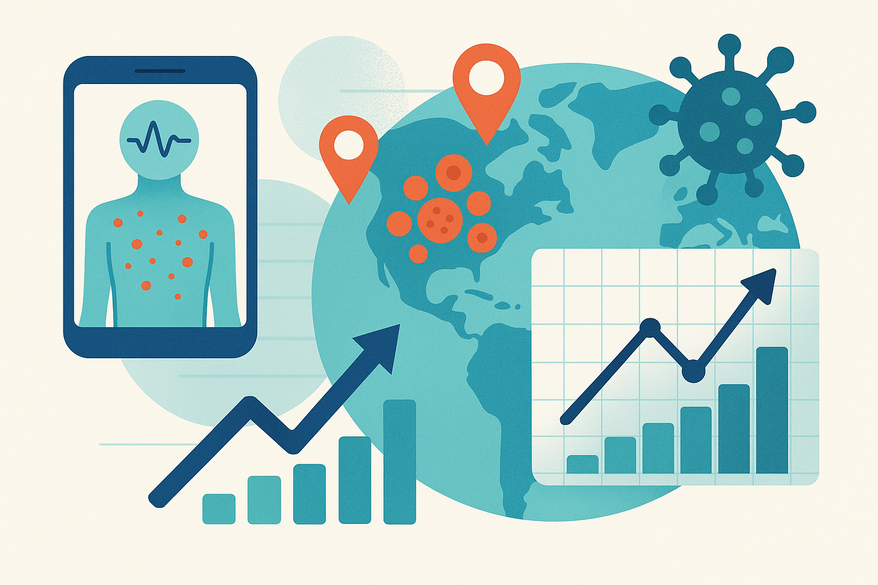How Public Health Insights from Rash Detector Data Are Revolutionizing Disease Surveillance
Discover how public health insights from rash detector data are transforming outbreak detection and disease surveillance, offering faster, data-driven responses.

Estimated reading time: 8 minutes
Key Takeaways
- Rash detector data leverages digital images and metadata for real-time outbreak monitoring.
- AI-driven analysis accelerates detection of fast-spreading skin conditions like mpox.
- Geospatial trend mapping enables targeted interventions and vaccination campaigns.
- Ensuring data privacy and equity in model training are critical for reliable insights.
Table of Contents
- Section I: Understanding Rash Detector Data
- Section II: Public Health Insights from Rash Detector Data
- Section III: Case Studies
- Section IV: Challenges and Limitations
- Section V: Future Trends
- Conclusion
- FAQ
Section I: Understanding Rash Detector Data

Definition of Rash Detector Data
- Rash detector data = digital images of skin conditions plus metadata (demographics, symptom duration, geolocation), collected via AI-powered apps, clinical reporting systems, and crowdsourced photo networks.
- Key sources include real-world initiatives:
Collection Methods
- Mobile Apps: The Rash Detector app prompts users to upload photos; AI classifies rash type and severity in seconds, assigning risk scores.
- Clinical Partnerships: Piction Health aggregates dermatologist-validated images from 18 countries, improving dataset representativeness.
- Crowdsourcing Initiatives: Google’s SCIN collects self-reported rash photos across diverse populations to fill gaps in conventional datasets.
Technical & Methodological Aspects
- AI & Machine Learning: Convolutional neural networks perform pattern recognition, classify rash morphology, and assign risk scores (learn more about machine learning in skin analysis).
- Data Quality Controls: De-duplication filters remove repeats, metadata validation checks age and skin tone, and encryption standards protect privacy (see symptom checker).
Importance of Accuracy & Timeliness
- Early Outbreak Alerts: Precise image analysis and rapid data ingestion are essential for flagging fast-spreading rashes, such as mpox.
- Detection Speed: Stanford found AI classification cut detection time by days in the mpox app.
Section II: Public Health Insights from Rash Detector Data
- Outbreak Surveillance
• Geotagged rash reports reveal spatial clusters of unusual skin events.
• Stanford used mpox app data to identify emerging hotspots before clinical cases spiked. - Trend Analysis
• Time-series monitoring of rash incidence across age groups and regions informs seasonal or regional variations.
• Piction Health’s global dataset (>500,000 images) showed clear seasonal rash peaks in temperate zones. - Disease Progression Tracking
• App metadata on symptom duration lets analysts track rash stages (macule → papule → vesicle).
• Modeling progression speed supports clinical guidelines on quarantine and treatment windows. - Policy & Intervention Strategies
• Health agencies use data signals to trigger targeted vaccination campaigns and public alerts.
• Mpox vaccination recommendations were refined based on rash trend analysis from app data.
Section III: Case Studies
- Mpox Early Detection
• Workflow: User-reported lesions → AI classification → health authority notification.
• Impact: Reduced time to diagnosis by an average of 3 days, enabling faster containment. - Global Equity in Dermatology
• Dataset Scale: Over 500,000 images across 18 countries via Piction Health.
• Outcome: Diagnostic accuracy for darker skin tones improved by 15%, closing health equity gaps. - Crowdsourced Surveillance (SCIN)
• Early-stage rashes, often missed clinically, were captured via smartphone submissions.
• Benefit: New window into outbreak emergence and demographic variations in rash presentation.
Section IV: Challenges and Limitations
- Data Accuracy Variability
• Image Quality: Poor lighting and focus can lead to misclassification.
• Performance Gaps: AI models underperform on rare skin tones without representative training data. - Privacy & Ethical Concerns
• Encryption: Data at rest and in transit must use AES-256 or higher.
• Anonymization: Workflows strip personal identifiers; user consent protocols are critical. - Integration & Interoperability
• Technical Hurdles: Merging crowdsourced, clinical, and EHR data requires standard APIs and data formats. - AI Bias & Training Data Gaps
• Under-Representation: Missing data on rare conditions or skin tones can skew model outputs.
• Misclassification Risks: Biased AI may miss early signs in marginalized populations.
Section V: Future Trends
- AI & Machine Learning Advances
• Next-gen CNNs will detect subtler rash patterns and pre-symptomatic markers.
• Predictive Modeling: Research aims to forecast outbreaks days before clinical cases rise. - System Integration & Real-Time Dashboards
• Unified Platforms: Live dashboards linking mobile apps, hospitals, and health agencies streamline response. - Health Equity & Global Surveillance
• Representative Datasets: Training AI on globally diverse images reduces bias and improves care access.
• Success Story: Piction Health’s inclusive dataset guided equitable intervention across skin tones.
Conclusion
Public health insights from rash detector data enable faster outbreak detection, better resource allocation, and more equitable care. By combining AI-driven image analysis with geospatial mapping and epidemiologic modeling, officials gain a real-time view of skin-related disease spread. Continued investment in AI-powered rash surveillance, secure data-sharing, and cross-sector collaboration will strengthen global health security and build a healthier, more resilient future.
FAQ
- What is rash detector data?
Rash detector data consists of user-submitted skin images and related metadata (age, location, symptoms) used for AI-driven analysis and public health surveillance. - How does AI classify rashes?
Convolutional neural networks analyze lesion morphology and patterns, assigning risk scores and identifying early signs of outbreaks in near real-time. - Are there privacy concerns?
Yes. To protect users, data are anonymized, encrypted (AES-256+), and subject to strict consent protocols before any public health use. - How can health agencies act on these insights?
Agencies use geospatial clusters, trend analysis, and progression tracking to deploy targeted vaccinations, issue alerts, and refine treatment guidelines.





